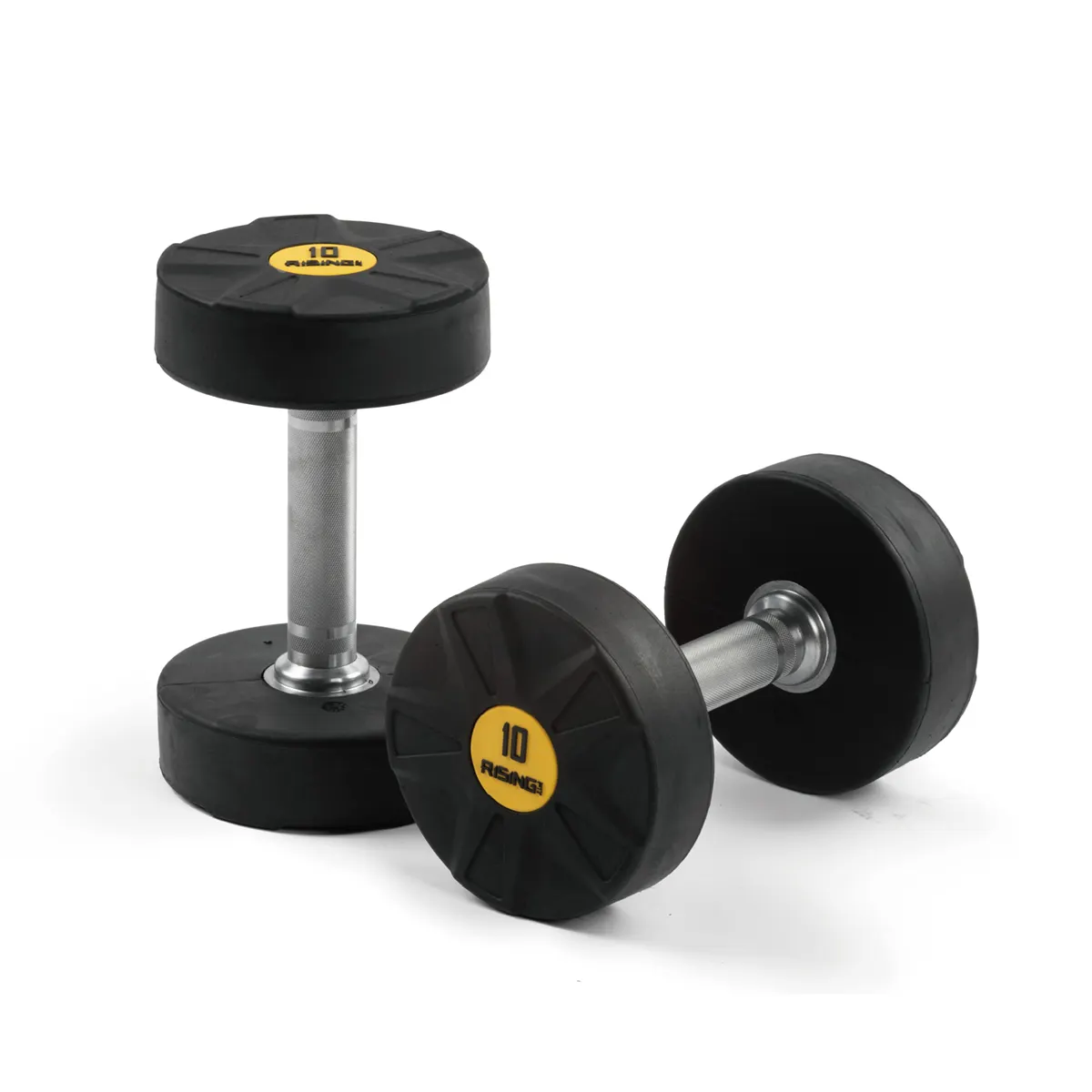Key Features of Powerlifting Barbell Plates
Material Durability for Heavy Loads
Material Durability If you looking for the best powerlifting barbell plates, it should be durable, especially if you need to withstand heavier loads. Plates are often constructed of materials such as cast iron and rubber, which have distinct properties that endure different amounts of stress. For example, cast iron is known for heavy use because it is very dense and strong; it can withstand much weight from other heavy equipment, such as water tanks, without eroding quickly. Rubber Coated Plates Rubber coated plates have the same precision benefits as their metal counterparts but are quieter and do less damage to the floor when dropped. Research has shown that cast iron plates last longer - for many years even under heavy stress. Rubberized coatings on the other hand increase durability by reducing wear and tear, providing a surface that is also aesthetically pleasing and longer-lasting in functionality. By using this combination of materials and finishes have enabled these plates to help meet the high level demands of powerlifting.
Weight Tolerance and Precision Standards
In competition, powerlifters demand precision and tolerance. These are all factors that make it an even competition and also greatly influence an athlete's ability to perform. Regulatory organizations (such as the IPF) prohibit such equipment and also ban or strictly limit knee wraps but generally we do allow up to 1% on the amount of elastic that could be used 3/2 inch (75cm) for example on a 29.5 inch (75cm) suit or 2m Knee Wrap. This accuracy is important as even minor variations can affect the athlete’s routine or performance. Veteran powerlifters often stress the significance of having plates that are same in weight, values, since the repeat-ability will breed confidence and familiarity during lifts. Such accuracy is crucial for the serious lifter who desires to perfect his technique as well as achieve new personal bests routinely.
Thickness vs. Load Capacity
The thickness of powerlifting plates is what effects their weight limit and performance. Thinner plates are typically able to hold more weight on a bar, which matters as you push your limits as a powerlifter. When it comes to different brands, most experts will point out that thick plates CAN give lifters a more solid ‘feel’ but they also take up more space on the barbell. Thin plates can increase power because not only must the plate be manufactured from high quality steel, but thinner plates allow more weight to be put onto the bar, without reducing lift stability and safety. Thus, understanding the trade-off between thickness and load capacity aids in choosing plates that are suitable for the user’s specific lifting.
Optimal Plate Materials for Powerlifting
Cast Iron: Traditional Strength
Cast Iron plates have been the go to weight lifting staple for years because of their low price and incredible durability when handling heavy loads used for weightlifting, powerlifting, and other extreme workout programs. The traditional iron plates have been a favourite in the market for many years due to their durability and simplicity which are a popular selection in commercial gyms. These plates are often preferred over their plastic counterparts by powerlifters for their unmatched durability and low bounce during use while doing heavy lifts. They are also budget-friendly, which is great for anyone trying to build a home gym.
Steel Calibrated Plates: Competition-Grade Accuracy
What you may not know is exactly how reliable and by-the-book accurate steel calibrated plates are – only the calibrating masters won’t even go there! The very precisely manufactured plates allow for fair contests of strength. These plates are favored by commercial gyms and are a perfect fit for any other gym environment due to their extreme durability. This precision matters to serious lifters, which is why precise is the name of the game.
Rubber vs. Urethane: Impact Resistance
Rubber & Urethane are the most impact-resistant materials used in weight plates. The pair of plastics have great shock absorbing properties, so may appeal to those who might be dropping their plates (in a home gym, or competitively). Rubber plates are sturdy and able to absorb impact. On the other hand urethane plates being somewhat heavier duty and resistant to wear are usually preferred for the better looks and low noise quality. These marcating plates and structural tubing are both built to last, providing safety and years of heavy lifting in your training facility.
Plate Design Considerations
Raised Lips for Secure Grip
Lip on barbell plates are raised to help you grip them when lifting, a feature that the powerlifting community holds in a very high regard. These ergonomic shapes ensure safe lifting, so athletes can concentrate more on performing at their best and less on the plates moving. Studies show that holding the bar in the correct position is not only safer, but also more effective during heavy lifts, minimising risk of injury. Raised lip, allowing lifters to easily pick plates up and handle plates, especially while doing lunges or during Albums where a lot of plate exchanges are done.
Hole Diameter and Barbell Compatibility
Speaking of hole size, it is crucial for compatibility with barbells, and will affect your lifts greatly. Go with the standard size hole and you should be able to fit both olympic and standard size bars as the hole sizes correspond to specific dimensions of olympic and standard bars. Olympic plates with 50mm holes will not fit on a standard bar, whereas a standard plate will have a hole of approximately 25mm. An ill-fitting plate can increase the risk of instability — a major safety concern, as well as the need to choose plates that correspond to your barbell type. It’s important to know these standards when selecting plates for your workouts.
Color-Coding for Quick Weight Identification
Using coloured weight plates can simplify situation where weights are constantly being applied and removed from a bar during an exercise routine giving both mental and physical help. A lot of gyms and meets use color-coding scheme (red = 25kg, blue = 20kg), so jump between the color plates to test yourself and your brain as well at what weight you’re lifting at. Studies have demonstrated that the adoption of colour in exercise equipment can assist to increase the user's efficiency while reducing the cognitive burden, allowing athletes to concentrate on making progress. That's why powerful imagery (and awesome products) is so important to Les Mills. So the gym and fitness brand has teamed up with Reebok to release a new line of color-coded gear.
Safety and Maintenance
Floor Protection Strategies
No matter what you’re working out in, heavy weights are not going to be gentle with your floor. The easiest way to protect your floor is to place a mat or platform beneath the weights to mitigate any impact and protect the flooring. Durable rubber mats (designed for gyms) are recommended by experts as they absorb shock. Cost comparison, during the long run, floor protection investment can save you a lot of money because you won't worry about replacement costs due to cracked tiles and damaged carpets.
Rust Prevention for Longevity
In order to guarantee it's durability rusting of Metal plates must be avoided through routine cleaning and oiling maintenance. If dress plates are stored in dry areas that are oiled once a month their lifetime is greatly increased. According to data, plates treated with rust-preventing agents last far longer than those that are not cared for, sometimes for years. Those who know how to keep the fitness equipments will actually recommend many of these tips to keep the equipment in good condition.
Inspecting Plates for Wear
Regularly check barbell plates to improve safety and performance. Look for cracks, chips and other wear and tear, as these may cause the lifting process to be unsafe and/or inefficient. By now, a lot of manufacturers will have established thorough inspection reports to help in spotting potential issues as soon as possible. Safety study found that using damaged plates can cause injuries, retard training results, importance of regularly check the plates to reduce the risk.
Budget vs. Professional-Grade Options
Entry-Level Iron Plates
Iron plates for beginners Iron plates are the best starting point for a beginner, simply because they are cheap and everywhere. These plates are designed to suit everyone, as they're available in a variety of weight increments – from 2.5 pounds all the way to 45 pounds – so beginners can start with lighter options and work up. Run of the mill brands like CAP Barbell and XMark Fitness frequently feature in starter sets. They don't cost much and are a great investment for people who's just starting their journey with weightlifting.
High-Capacity Steel Plates
High Strength Steel Plate Offers Lifters Best Option for Performance Optimization These plates are ideal for serious trainers and competitive lifters looking for serious weight ranges and durability. Steel plates for training or competitive lifting that are built to last by powerlifting standards. They can be more expensive on the front-end, but they last longer, making for a much lower cost-per-use than cheaper options.
When to Invest in Competition Calibrated
Knowing when to buy competition-quality plates is important for peak efficiency lifters. These plates are genuinely created to weigh exactly and have a very low off-weight.During many hotel resistance workouts, consistent weight is of primordial importance, and these do their job. Calibrated plates can take performance to the next level as more experienced lifters often describe the stability and feel of the lifting stance. The uniform weight distribution of these crumb have given more control to the lifters, this can be vital in events when everything matters.
FAQs
What materials are commonly used for powerlifting barbell plates?
Powerlifting barbell plates are typically made from cast iron, steel, rubber, and urethane, each offering unique benefits such as durability, precision, and impact resistance.
Why is weight tolerance important in powerlifting?
Weight tolerance ensures fair competition and affects athlete performance by ensuring plates have precise measurements, contributing to consistency during lifts.
How can I protect my gym floor from damage?
Using rubber mats or platforms designed for gyms can effectively absorb heavy impacts and protect the flooring from damage during workouts.
What is the difference between rubber and urethane plates?
Rubber plates are known for their shock absorption and durability, while urethane plates offer advanced resistance to wear and lower noise levels, making them ideal for frequent use.
When should I consider investing in competition-calibrated plates?
Investing in competition-calibrated plates is advisable when an athlete is aiming for precision and consistency in lifting, particularly in competitive environments where exact weight measurement is crucial.


